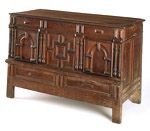Craftways: English Artisans in Seventeenth-Century New England
Decorative Arts Gallery
Craftways will feature thirty of the most important surviving furniture forms made by early English settlers in the North American colonies. The exhibition looks at how English technological and artistic conventions—or “craftways”—changed in reaction to their new environments and social communities. Six distinct groups of furniture trace this evolutionary process and suggest the different ways that English craftsmen adapted their old habits and developed new skills.
When English families arrived on this unfamiliar continent, they reacted in different ways to new surroundings and needs. The furniture on view provides the best clues about how they adjusted their “craftsways” to fit their new situations. One group of oak chests and boxes made in Marshfield, Massachusetts in the 1690s suggests that several families of craftsmen brought distinct habits of construction and design. Once living and working together on American soil, they combined specific elements of each tradition to make a new type of furniture. In contrast, a folding table made in Boston was made by a craftsman who altered his habits once he arrived in Boston, where a single family already dominated furniture production. By developing new hybrid “craftways”, these furnituremakers helped define the aesthetic landscape of early American towns and cities.

